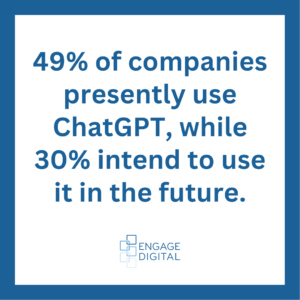As the digital landscape constantly evolves, businesses must adapt swiftly to maintain a competitive edge. Chat GPT-4, the latest generative pre-trained transformer from OpenAI, stands at the forefront of this transformation. Consequently, understanding its trajectory and applications in business marketing is paramount.
The Evolution of Generative Pre-trained Transformers
Initially, the inception of GPT by OpenAI in 2018 marked a revolution in natural language processing (NLP). Its successor, GPT-2, was lauded for its enhanced text generation capabilities. However, it was GPT-3, introduced in 2020, that truly showcased the vast potential of these models, with its ability to generate human-like text. Now, GPT-4 has expanded upon this foundation, offering even more refined and nuanced language generation.
For businesses, the implications are significant. According to a Salesforce survey, 84% of customers value experience as much as products or services. With GPT-4, companies can craft personalized experiences at scale. In essence, this technology can engage users with human-like interaction, automating and personalizing customer service and marketing campaigns.
Integrating Chat GPT-4 in Business Marketing
Embracing Chat GPT-4 for business marketing heralds a new era of customer interaction and content creation. With this AI, personalized marketing isn’t just a buzzword—it’s a tangible reality. Companies can now craft customized experiences that resonate on an individual level, something that’s essential in today’s market. Personalization is so crucial that it can swing a customer’s loyalty toward a brand.
Moreover, GPT-4’s content generation skills are not just fast but also strikingly nuanced. Whether it’s engaging blog posts, sharp product descriptions, or catchy ad slogans, this AI tool can do it with finesse. For instance, businesses that utilize blogging effectively receive significantly more leads, highlighting content’s pivotal role in marketing success.
Lastly, GPT-4’s data interpretation is a game-changer for targeted marketing. It sifts through customer data, spotting trends and preferences that can sharpen marketing campaigns. With Forbes noting an uptick in customer satisfaction for AI-analytics adopters, it’s clear that GPT-4’s insights are invaluable for creating a marketing strategy that not only reaches but truly speaks to your audience.
Maximizing Marketing Efforts with GPT-4
Harnessing GPT-4’s capabilities can significantly enhance customer interaction. This technology allows for the customization of dialogues in real-time, leading to a more engaging and relevant customer experience. Importantly, personalizing these interactions can foster greater customer loyalty, as it reflects an understanding of individual preferences and needs.
Furthermore, GPT-4 streamlines content production, enabling marketers to quickly generate high-quality material. This efficiency frees up creative teams to focus on strategic and complex tasks, rather than getting bogged down with the demands of content volume. As a result, businesses can maintain a constant flow of fresh content, crucial for keeping the audience engaged and interested.
Additionally, the cost benefits of incorporating GPT-4 are noteworthy. By automating routine content generation and customer interactions, businesses can allocate their resources more effectively. This shift not only leads to savings on labor but also enhances the productivity of marketing efforts, giving companies the leeway to innovate and refine their marketing strategies further.
However, this is not to say that GPT-4 is without its drawbacks. As with any technology, there are considerations to be made.
 Weighing the Pros and Cons
Weighing the Pros and Cons
Let’s dive into the upsides and possible downsides of using Chat GPT-4 for a fresh spin on your marketing game.
Advantages of Chat GPT-4 for Marketing
The efficiency of Chat GPT-4 in creating content offers a significant edge to marketers. This AI technology excels at producing a variety of content types swiftly, easing the burden on marketing teams. With its advanced capabilities, GPT-4 ensures that content is not only generated quickly but also meets a high quality standard, engaging the target audience effectively.
In addition, GPT-4’s understanding of natural language enables it to tailor content and interactions to specific customer contexts. This level of personalization can significantly boost customer experience, setting a brand apart in a crowded marketplace. By providing interactions that feel more human and less scripted, businesses can cultivate a sense of connection with their customers.
Moreover, the cost-effectiveness of GPT-4 cannot be overstated. Automating routine marketing tasks reduces overhead costs and allows human staff to concentrate on higher-level creative strategies. This not only leads to direct financial savings but also optimizes the overall marketing workflow, enabling a more strategic allocation of human resources.
Potential Drawbacks to Consider
While Chat GPT-4 is a powerful tool, it’s not without its limitations. A key concern is the potential loss of brand uniqueness. Although GPT-4 generates content efficiently, it may not always capture the distinctive voice and flair that differentiate a brand from its competitors. Brands risk diluting their identity with content that doesn’t quite hit the mark in terms of style and originality.
Moreover, there are ethical considerations. The misuse of AI in creating deceptive or misleading content could harm a brand’s credibility. It’s vital to use GPT-4 responsibly, ensuring content is accurate and truthful to maintain trust with your audience. This is particularly important as consumers increasingly value transparency and authenticity from the companies they patronize.
While automating customer interactions can improve efficiency, it can also reduce the human touch that often forms the cornerstone of customer loyalty. Personal connections fostered by real people can be crucial in retaining customers. Thus, it’s important to strike a balance between leveraging AI capabilities and maintaining genuine human engagement.
Preparing for a Future with GPT-4
Looking ahead, integrating Chat GPT-4 into marketing strategies demands a thoughtful approach. It’s about harnessing the strengths of AI while keeping its limitations in check. Companies need to navigate the fine line between automation and human touch, ensuring they deliver personalized experiences without losing the essence of human empathy.
For businesses ready to embrace this technology, the future is bright. Those who use GPT-4 wisely—balancing its efficiency with a dose of human creativity—will likely see their marketing efforts flourish. In a world where adaptability is key, the blend of AI innovation and human insight could well be the winning combination for the next generation of marketing success.






